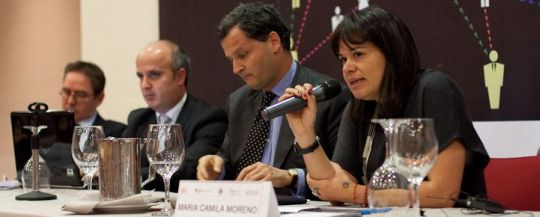A Call to Trust in State Institutions

After an intense day of exchange between academics, international organizations, and representatives from countries that have used transitional justice processes, Sergio Jaramillo, high counselor for security, Diego López Medina, professor at Los Andes University, and ICTJ’s Paul Seils presented. ICTJ’s María Camila Moreno moderated the session.
López, an academic and advisor to the Attorney General, gave his vision of how the Justice and Peace Law has created the possibility to apply (or not apply) selection and prioritization mechanisms. After several years of debate about this, López believes the principle reason that such mechanisms haven’t been adopted thus far is because “its difficult to explain them to victims.”
He continued by saying, the Colombian victims’ movement sees such mechanisms as a form of creating an improper amnesty and a hidden law, in the end.
“I would say that Colombian civil society is very split,” he affirmed. On one hand, it is concerned with pragmatic movements, related to human rights, that do not have confidence in the Justice and Peace Law because of its murky origins, and because it was not the result of pubic debate, but a relatively closed bilateral negotiation between the state and the paramilitaries. These same movements now consider the process to have been worthwhile in making an affective contribution to reducing conflict.
Government Principles
Sergio Jarmillo opened his presentation with the a key question: “What is the legal framework that is going to help us resolve the violence in Colombia?” He laid out three basic principles that should complement this framework: utility, temporality, and limitation.
The first principle of utility in the transitional framework signifies that the framework has to help the country resolve the problem of violence. The second principle, of temporality, should determine what is the end of the transitional process. And the third, of limitation, establishes the context of the internal armed conflict as a determining factor of what is included in the process.
Before the initiatives to radically change the Justice and Peace Law, Jaramillo made a call to have confidence in the country’s instruments. “We cannot have a clean slate. We have to respect what has already been created,” he said.
He referred also to the coherence between Colombia’s adopted transitional justice methods. He recalled the message in which the president called the combination “a quilt.” Jaramillo said that the suggestion is to not invent new justice instruments, but to search for the coherence between the different things that will be invented.
He ended by expressing that instead of trying to figure out “how to do it,” it is important to decide what we are trying to do, and define whatever that is together with different sectors of society and with respect to the country’s obligations under the Inter-American system and the Rome Statute.
Paul Seils then referred to concrete experiences, like that of Timor-Leste, where procedures for community reconciliation were established as part of the truth commission. Under this transitional justice system, the perpetrators from lower ranks presented their declarations and were approved by committee. The UN administered government had to confront a problem, which is that these perpetrators had committed crimes against humanity: they had consciously participated in systematic attacks against the civilian population, razing houses, killing people, knowing that this was part of a political campaign.
This special community reconciliation procedure did not shelter people who had committed grave crimes, and therefore, it as not applicable to many people. To resolve this, the authorities changed a line to say that “in principle” people who had committed graves crimes are not eligible to benefit from the process. This modification gave the prosecutor discretion that he didn’t have before. In this way Timor-Leste created a system in which people of lower ranks could give their declarations, and more than 1,000 people then went through the community reconciliation process.
Photos by Camilo Aldana
Video by Mauricio Cardona
